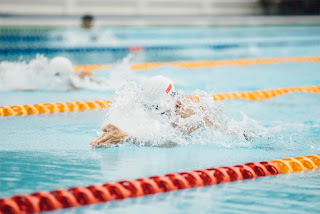Swimming Form: 4 Ways To Improve Yours
This article was written by Mick and has some very useful information about swimming sites in the UK and ways to improve your swimming form.
Richard
Are you ready to take your fitness to the next level?
 |
| It's not about the number of Laps |
Swimming is a fantastic way to keep fit and has the added benefit of providing a supportive environment for the body in which to train. The benefits of swimming are many and include cardiovascular fitness, increased muscle tone, endurance, and weight loss.
It’s also a low-impact activity that doesn’t put unnecessary stress on the body.
A regular dip is a powerful form of exercise, but it’s a misnomer that the only way to improve your swimming routine is to simply add more lengths and clock up the distance. Improving your swimming form also involves refining your technique. It’s all about working smarter, not harder.
I've put together our 4 top tips for improving your swimming form. If you don’t have a local municipal pool there are plenty of other places you can go for a dip. Read on to find out more.
Where to go:
There are many options for swimming, from sea swimming and swimming in natural pools, to municipal pools, private swimming clubs and if you are lucky enough, even swimming at home in your very own pool.
The Outdoor Swimming Society is a worldwide community promoting the joy of swimming under an open sky. On their site, you’ll find a map of lakes, rivers, estuaries, good sea spots, tidal pools and lidos.
Swim England has a list of local swimming baths in England, Scotland and Wales. The Poolfinder allows you to search for your local pool. If you’re a committed swimmer, you may want to take the plunge, so to speak, and join a club to become a competitive swimmer.
Or if you prefer the privacy of swimming at home, seek out a reputable pool builder, and add a luxurious pool in your own house or garden.
5 top tips to improve your swimming form
- Set realistic expectations
- Get the right gear and props
- Get to know swim-speak
- Get a swim coach
Don’t equate an hour’s running with an hour in the pool. If you are new to a swimming regime, even if you are very fit, you probably can’t swim that far or for that long. When you first start swimming, you don’t need to swim for a long time or swim in an Olympic-size pool. Start with realistic expectations and gradually build on them.
Swimming requires sport-specific training. An hour in the pool is not the same as an hour in the gym, or on the running machine. Set realistic targets and goals to create milestones that are achievable and make you feel like you have accomplished something. Literally, start with one or two lengths of the pool without stopping. Then add more laps once you are successful.
You really don’t need much gear to get started with a swimming routine. You’ll need a comfortable training swimsuit, a decent pair of goggles and a swim cap. You may also want to use earplugs and a nose grip. However, be aware that you have a greater tendency to hold your breath if using a nose clip and that will make breathing less efficient. Inefficient breathing prevents the body from relaxing and ultimately affects the fluidity of your stroke. You’ll need to weigh up whether nose clips are right for you.
You will also need a pull buoy (a specially shaped float that sits between your legs and allows you to concentrate on your arm stroke), hand paddles (used to develop upper body strength), and a kickboard (used to isolate and develop leg movements).
 |
| A regular dip is a powerful form of exercise |
If you are joining a swim club, you’ll need to familiarise yourself with the language used for swim session workouts. A typical swim session consists of a warm-up, the main workout and a cool-down. Even if you are swimming under your own steam, there are some free apps you can use to keep track of your workouts. For a more serious swim app, try the MySwimPro for the Apple watch. Depending on the app, you may still need to understand the swimming code.
The language of a swim workout is fairly simple and made up of abbreviations. At swimming club sessions, there is usually a board with swim work-outs written up, and most coaches use the common abbreviations consistently. To begin, swimmers count yards, not laps (or lengths). Workout sets are usually written something like this: 4 x 100 on the 2:00. This means you have 2 minutes to swim 100 yards before the next repetition, a total of 4 times. Rest is included in the 2 minutes, so the faster you go the longer you get to rest.
Another example may be a workout that calls for a 200-yard warm-up, often abbreviated as “200 ez warm-up” (ez is an abbreviation of easy). This means you will swim 8 x 25-yard lengths (down and back 4 times) of a 25-yard pool. Easy infers relaxed swimming. Deciphering swim code may seem a little daunting at first, but it’s easy to learn. Ask your swim coach if you are unsure.
If you are serious about using swimming as a means for a workout and improving your fitness level, then getting a swim coach will help you master the strokes and improve your speed. Most swim clubs are open to all, except those who are learning to swim for the first time, so there’s no excuse for not joining a group. Even a few private lessons with a swim coach will give you pointers for the best way to improve.
Good luck with your swimming training! Go for it!

No comments:
Post a Comment